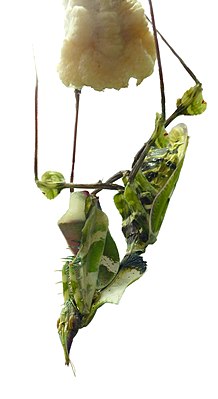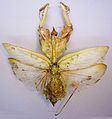Devil flower
| Devil flower | ||||||||||||
|---|---|---|---|---|---|---|---|---|---|---|---|---|

Devil flower ( Idolomantis diabolica ), female with ootheca |
||||||||||||
| Systematics | ||||||||||||
|
||||||||||||
| Scientific name of the genus | ||||||||||||
| Idolomantis | ||||||||||||
| Uvarow , 1940 | ||||||||||||
| Scientific name of the species | ||||||||||||
| Idolomantis diabolica | ||||||||||||
| ( Saussure , 1869) |
The devil flower or Big devil flower ( Idolomantis diabolica ) is not a plant , but a species of insect from the order of the Mantis (Mantodea). The vernacular name was chosen because of the plant-like appearance of the animal. This external adaptation is used for camouflage . The species occurs in East Africa and is the only representative of the Idolomantini tribe and thus also of the Idolomantis genus .
features
The females reach a body length of around 13 centimeters, sometimes even 14, the males are only about 11 cm tall. The wings are well developed in both sexes, the wingspan of the females is up to 16 centimeters. When at rest, the wings reach the end of the abdomen .
The species is light brown or green in color, the hue varies considerably. The larvae are black to dark brown in color. The pronotum (front chest) is very long and slender, longer than the coxes of the fangs. These have large, leaf-shaped lobes that play an essential role in the threat attitude. Long thorns sit on the femora of the front legs, between which there are always three short thorns. There are also leaf-like appendages on the two rear pairs of legs, which consist of enlarged duplicates of the cuticle . The vertex of the head is conically pointed in front of the compound eyes .
The females are larger and more massive than the males and have six or seven segments, the males have eight segments. Even from the subadult stage, males and females can be clearly distinguished from one another based on the nature of their antennae. The antennae of the males are double combed, while females have thin, unbranched antennae .
Occurrence
The range of the species extends over the East African states Ethiopia , Somalia , Kenya , Malawi , Tanzania and Uganda .
Way of life

The devil flowers are diurnal ambulance hunters. Their appearance, which imitates leaves, serves as camouflage. When living beings adapt to a part of their living space in shape, color and posture, so that they are now difficult to perceive for the optically oriented roommates of this living space, one speaks of mimesis . This camouflage serves on the one hand to protect against predators, on the other hand, potential prey cannot easily locate the ambulance hunter in this state.
The threatening posture, in which the fangs are spread so that the colors can be seen on the underside of the leaf-shaped lobes and on the thorax, was often interpreted by researchers in the 19th century as an imitation of a flower intended to attract insects. This is where the German name Teufelsblume comes from. An adaptation in which animals are attracted by deception is called Peckham's mimicry . Although the antennae are sometimes similar in color to the stamens and the conical part of the head drawn forward could be viewed as an intermediate stamp of a flower, the prevailing view today is that the mimetic adaptations of the devil's flower are not at the same time a shape the mimicry acts.
The species feeds on flying insects, i.e. flies , butterflies , bees , wasps , bumblebees and grasshoppers . It does not eat crickets , which are otherwise often used for feeding in the terrarium. If there is insufficient food supply, problems with ooth formation can arise.
The ootheca is whitish to cream colored and oval in shape. In the first larval stage, the fishing fright prey on gold flies , which are also their preferred food in the adult stage. The eighth moult, after around six months, is called the maturity moult. After this last molt, the animal becomes sexually mature. Then the female lives on for six to eight months, the males usually die soon after mating.
Systematics
Idolomantis diabolica was described by Henri de Saussure in 1869 as Idolum diabolica . Shelford used the name Idolum diabroticum in 1903 . This was put by Beier as a synonym for Idolum diabolica in 1934 . 1940 Boris Petrowitsch Uvarow put the species in the genus Idolomantis established by him . Within the subfamily Blepharodinae , it is the only representative of the Idolomantini tribe.
attitude
Because of its size and color, the devil flower is also known as the “queen of the terrors” and is a popular animal for hobbyists. The demand for these mantids is greater than the supply. If the terrarium is large enough, they can be kept in groups with almost no problems. As a tropical insect, the devil flower is used to high temperatures, high humidity is essential for the last moult and for adult animals.
gallery
Illustration of a threatening gesture of the Teufelsblue from a report by the Senckenberg Natural Research Society in Frankfurt am Main
Idolomantis diabolica from the Munich State Zoological Collection
literature
- I. and R. Bischoff, C. Hessler, M. Meyer: Mantids: Fascinating Lauerjäger. Edition Chimaira, 2006 ISBN 3-930612-45-3
- Reinhard Ehrmann: Mantodea: praying mantises of the world. NTV, 2002 ISBN 3-931587-60-6
- Alfred Kaestner, Arno Wetzel: Textbook of special zoology. Volume 1: Invertebrates. 3rd part: Insecta. Gustav Fischer Verlag, Jena 1972, pp. 358–359 ISBN 3-43730-177-2
Individual evidence
- ↑ David Oliveira: Key to Preying Mantis Earthlife.net (Engl.)
- ↑ Devil's flower in threatening position ( memento of the original from March 3, 2011 in the Internet Archive ) Info: The archive link has been inserted automatically and has not yet been checked. Please check the original and archive link according to the instructions and then remove this notice. Picture at Zooillogix
- ^ Heinrich Georg Bronn: classes and orders of the animal kingdom. Part 3. CF Winter'sche Verlagsbuchhandlung, Leipzig 1880, new edition 1964, p. 929
- ^ Henri de Saussure: Essai d'un Système des Mantides. Communications from the Swiss Entomological Society = Bulletin de la Société entomologique suisse, 3, 2, pp. 49–73, Schaffhausen / Switzerland 1869, p. 60
- ↑ Otte, Daniel, Lauren Spearman and Martin BD Stiewe. Mantodea Species File Online. Version 1.0 / 4.0 (accessed March 1, 2011)
- ↑ Idolomantis diabolicum at Swissmantis.ch ( Memento from April 5, 2012 in the Internet Archive )


